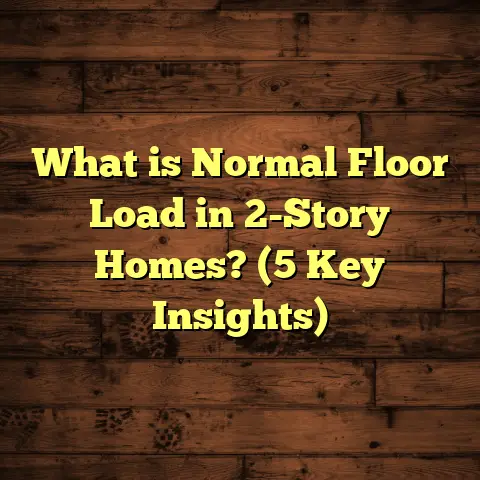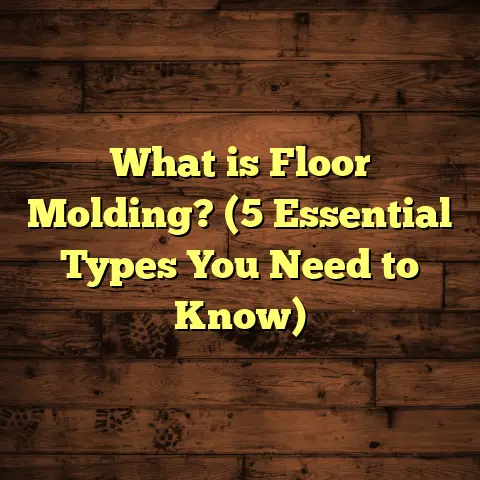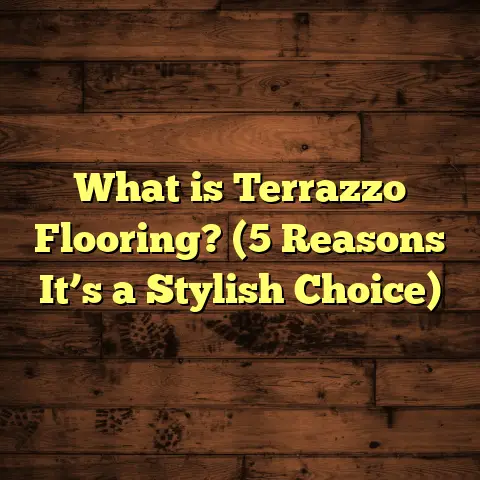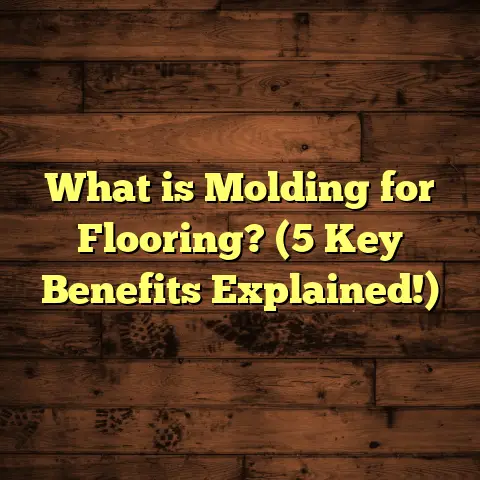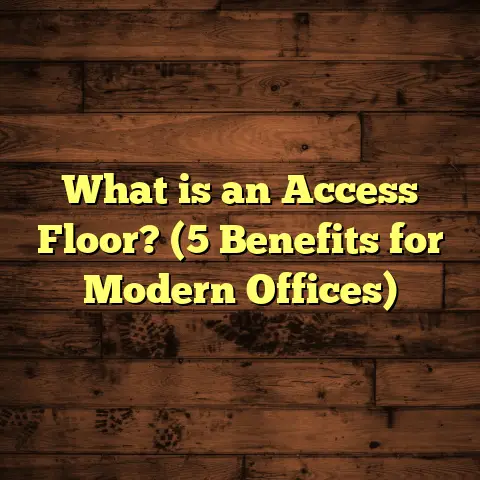What is RVP Flooring? (5 Must-Know Benefits for Your Home)
Have you ever thought about a flooring type that sounds like it’s from a high-tech lab but is actually designed for everyday homes? RVP flooring might just be that surprising mix of innovation and practicality. I remember when I first encountered RVP flooring; I was skeptical about how it could stand up to the wear and tear of a busy household. But after working with it on several projects, I found it ticks off so many boxes that it quickly became one of my go-to recommendations.
What Is RVP Flooring?
RVP stands for Rigid Vinyl Plank flooring, a type of vinyl flooring that combines the durability and waterproof qualities of vinyl with a rigid core that offers additional toughness and stability. Unlike traditional vinyl sheets or tiles, RVP comes in planks that mimic the natural look and texture of hardwood or stone.
This flooring has a layered construction:
- Wear Layer: A protective top coating that resists scratches and stains.
- Vinyl Layer: Printed with high-resolution designs replicating wood grain or stone patterns.
- Rigid Core: Usually made from limestone composite or WPC (Wood Plastic Composite), which provides rigidity and helps the floor resist dents and impacts.
- Backing Layer: Adds stability and moisture resistance.
The result is a floor that looks great, is tough, and handles moisture better than most other hard surface floors.
Why Should You Care About This?
If you’re like me and have kids, pets, or just a busy lifestyle, you want flooring that can take a beating without losing its charm. And if you’re worried about water damage — say in your kitchen or bathroom — RVP’s waterproof core makes it a smart choice.
Where Does RVP Flooring Fit in Your Home?
I’ve installed RVP flooring in kitchens, basements, and even laundry rooms because of its water resistance. It’s also great for entryways and mudrooms where wet shoes and dirt are common.
What about living rooms or bedrooms? Absolutely! The realistic wood looks make it cozy and stylish enough for any room.
Compared to hardwood, which can warp with moisture, or laminate, which may swell when wet, RVP stands firm. That means fewer worries about spills or humidity.
My Personal Experience With Installation
When I first started installing RVP flooring, I was curious about how it compared to laminate or hardwood installation. The process turned out to be fairly straightforward.
Here’s what I learned firsthand:
- Subfloor Prep: Just like with any hard surface floor, the subfloor needs to be clean, dry, and level. I’ve seen some installers skip this step and regret it later when planks don’t sit right.
- Floating Installation: Most RVP floors use a click-lock system that lets you float the floor over the subfloor without glue or nails. This makes installation quicker and easier, especially for DIYers.
- Cutting: I use a utility knife or fine-tooth saw to cut the planks. They’re easier to work with than hardwood because you don’t need special blades.
- Expansion Gap: Leaving a small gap around the room edges allows the floor to expand and contract naturally without buckling.
One time, we had a tricky-shaped kitchen with lots of corners. The flexibility of RVP made it easier to fit pieces snugly compared to rigid tile.
How Do You Maintain RVP Flooring?
Maintenance is where RVP really shines. From my experience, here’s how I keep floors looking their best:
- Regular Sweeping or Vacuuming: Keeps grit and dirt from scratching the surface.
- Mopping: Use a damp mop with mild cleaner. Avoid harsh chemicals or abrasive tools.
- Spill Clean-Up: Wipe spills quickly to prevent any chance of staining.
- Furniture Protection: Placing pads under heavy furniture prevents indentations.
In one client’s home with two dogs, their RVP floor looked nearly new after 3 years, despite daily paw traffic and occasional muddy paws.
5 Must-Know Benefits of RVP Flooring For Your Home
1. Waterproof Durability
One standout feature is waterproofing. The rigid core combined with vinyl layers means water won’t seep through. Perfect for kitchens, bathrooms, basements — anywhere moisture is a concern.
Data Point: According to industry tests, RVP flooring can withstand 24 hours of standing water without damage, unlike laminate that swells within hours.
2. Realistic Aesthetic Appeal
RVP flooring mimics natural materials so well that even close inspection is tricky. The high-definition printing technology captures wood grains, knots, and stone textures beautifully.
I once had a client hesitant about vinyl because they wanted real hardwood look. After showing samples of RVP with embossed textures, they were sold.
3. Easy Installation Saves Time and Money
Because of the click-lock design, installation is faster than traditional hardwood or tile. This reduces labor costs if you hire professionals or makes it doable for confident DIYers.
In one project, our team finished 500 sq ft in under two days — much faster than expected for hardwood.
4. Comfort Underfoot
Unlike tile or stone, RVP has some give thanks to its core layer. It feels warmer and softer while still being firm enough for heavy foot traffic.
From personal experience installing in basements, clients appreciate not having that cold hard floor feel.
5. Low Maintenance with High Longevity
No waxing or sanding required. Just simple cleaning routines keep the floor looking fresh for years.
Case Study: A family in Ohio reported their RVP floor still looked great after 7 years despite kids playing sports indoors and frequent spillages.
How Does Cost Compare?
You might wonder how RVP stacks up price-wise against hardwood or laminate. Generally, RVP falls between laminate and mid-range hardwood costs.
On average:
| Flooring Type | Cost per sq ft (materials + installation) |
|---|---|
| Laminate | $3 – $7 |
| Rigid Vinyl Plank | $4 – $9 |
| Hardwood | $8 – $15 |
I use tools like FloorTally when estimating costs for clients. It helps me calculate total expenses based on local market rates for materials and labor instantly. That way, I’m confident about sticking within budgets without surprises.
What About Environmental Impact?
Many brands now offer RVP made with recycled materials and low VOC emissions. It’s not perfect compared to solid wood but better than some other synthetic floors.
If sustainability matters to you, ask suppliers about certifications like FloorScore or GreenGuard when choosing your planks.
Breaking Down Installation Challenges: Tips From My Toolbox
Not every job is smooth sailing when installing RVP flooring; challenges do pop up but knowing what to expect helps a lot.
Subfloor Imperfections
Sometimes subfloors aren’t perfectly flat or have bumps—these can cause planks not to lock properly or uneven surfaces down the road. I always recommend using a leveling compound on concrete floors before proceeding.
Temperature Conditions
RVP flooring expands and contracts slightly based on temperature changes. When installing in places with big temperature swings (like unheated basements), leaving proper expansion gaps is even more crucial.
Doorways & Transitions
Cutting around door jambs or transitions into other flooring types can be tricky. Having the right tools—a pull bar and tapping block—makes fitting pieces tight without damage easier.
Adhesive vs Floating
While most RVP floors are floated, some manufacturers recommend glue-down methods for extra stability in commercial spaces or heavy traffic areas. Always check the guidelines before starting.
What Makes RVP Different From Other Vinyl Floors?
You might wonder how Rigid Vinyl Plank compares to luxury vinyl tile (LVT) or traditional vinyl sheet flooring.
- Rigid Core vs Flexible Core: RVP has a stiffer core providing better impact resistance while LVT tends to be more flexible.
- Thickness: RVP usually ranges from 4mm to 8mm thick; traditional vinyl sheets are thinner.
- Installation: RVP often installs as floating floors; vinyl sheets require adhesive.
- Durability: The rigid core helps resist dents better than flexible vinyl options.
These differences affect where each product fits best depending on your home’s needs.
Can You Install RVP Over Existing Floors?
One question I get asked often is whether you can install RVP over existing flooring like tile or vinyl.
Good news: Yes! As long as the existing floor is level and firmly attached, installing RVP over it can save time and cost on removal.
However:
- Uneven surfaces may cause problems later.
- High spots should be sanded down; low spots filled.
- Avoid installing over carpet because it lacks stability.
How Long Does RVP Flooring Last?
Durability depends on quality of material plus care taken during installation and maintenance. On average:
- Well-maintained RVP floors last anywhere from 10 to 20 years.
- Some premium brands offer warranties up to 25 years residential use.
In my experience working on dozens of homes over several years, those who clean regularly and avoid dragging heavy furniture tend to keep floors looking fresh longer.
What About Sound Insulation?
If sound transfer bothers you, consider adding an underlayment beneath your RVP planks. Many brands include an attached foam backing but sometimes an extra layer helps reduce footsteps noise especially in apartments or multi-story homes.
I had one client who was surprised how much quieter their living room became after adding soundproof underlayment below new RVP floors.
Can You Refinish or Repair RVP Flooring?
Unlike hardwood floors that can be sanded and refinished multiple times, RVP cannot be refinished because it has a printed top layer protected by a wear layer instead of solid wood.
But repairing damaged boards is possible:
- Individual planks can be replaced if damaged.
- Minor scratches may sometimes be buffed out using special vinyl repair kits.
I once replaced several planks in an office where rolling chairs caused surface indentations—worked perfectly without replacing the entire floor.
How Does RVP Perform in High-Traffic Areas?
Whether it’s a busy household with kids running around or commercial spaces like boutique stores, durability matters most.
RVP stands up well due to:
- Thick wear layers (typically around 12 mils or higher).
- Scratch-resistant coatings.
- Tough rigid core preventing dents from dropped objects.
In one restaurant project I consulted on, the owner was impressed by how well the floor resisted scuffs even after heavy daily foot traffic for months.
Are There Style Options Beyond Wood Look?
Definitely! While wood-look planks dominate the market due to their classic appeal, you can also find:
- Stone-look planks resembling marble or slate.
- Abstract patterns for modern interiors.
- Textured finishes like hand-scraped wood or embossed leather looks.
This variety allows you to get creative with your home’s design without sacrificing durability.
How Does Temperature Affect RVP Flooring?
RVP generally performs well in both hot summers and cold winters thanks to its composite core materials. However:
- Extreme temperatures could cause slight expansion/contraction.
- Avoid placing near direct heat sources like wood stoves or space heaters without proper protection.
I’ve installed floors for clients in northern states who reported no issues despite harsh winters indoors thanks to proper acclimation before installation.
What Kind of Warranty Comes With RVP Flooring?
Warranty terms vary by manufacturer but typically cover:
- Wear layer durability against stains and scratches.
- Structural integrity under normal residential use.
For example:
- A common warranty period is 15–25 years residential use.
- Commercial warranties tend to be shorter due to heavier usage patterns.
Always read warranty details carefully—some exclude damage from improper installation or maintenance neglect.
Comparing RVP Flooring With Hardwood: Which Should You Choose?
Hardwood floors have undeniable beauty and prestige but come with drawbacks like sensitivity to moisture and higher cost. Here’s how I break it down when advising clients:
| Feature | Hardwood | Rigid Vinyl Plank |
|---|---|---|
| Cost | Higher upfront | Moderate |
| Moisture Resistance | Low (warps easily) | High (waterproof) |
| Maintenance | Requires refinishing | Easy cleaning |
| Durability | Can dent/scratch | Scratch & dent resistant |
| Installation | Nail/glue down | Floating click-lock |
| Appearance | Natural wood grain | Realistic wood/stone visuals |
If you want authentic wood feel and are ready for upkeep, hardwood’s ideal. For busy homes needing durability plus style at lower cost, I lean toward recommending RVP more often now.
Customizing Your RVP Flooring Project
One of the great things about this flooring is how easily you can tailor it:
- Mix plank widths for unique patterns.
- Combine different colors in open floor plans.
- Add decorative borders using coordinating tiles or planks.
I recently helped a client create a “rustic modern” look by mixing wide plank dark walnut tones with lighter grayish oak boards — turned out stunning!
Practical Tips For DIY Installation
Thinking about tackling installation yourself? Here are some tips from my tool belt:
- Acclimate your planks for 48 hours before installation inside your home environment.
- Use spacers to keep expansion gaps consistent around edges.
- Snap planks together firmly but gently to avoid damaging locking mechanisms.
- Work row by row checking alignment frequently.
Trust me — taking your time during prep saves headaches later!
How FloorTally Helps Me Manage Costs Efficiently
Estimating total project costs accurately can be tricky because prices vary by location, material choice, labor rates, waste factor, and more. FloorTally has been a game-changer for me on this front.
It pulls local pricing data automatically so when I enter room dimensions and material preferences:
- It calculates material needs including waste allowance.
- Estimates labor costs based on typical rates in the area.
- Gives me clear breakdowns showing what portion goes to materials vs labor.
This clarity allows me to provide clients realistic budgets upfront so nobody gets sticker shock halfway through the job.
Real Life Case Study: A Basement Transformation With RVP Flooring
A family contacted me wanting to finish their damp basement into usable living space but worried about moisture ruining traditional hardwood floors there.
We chose rigid vinyl plank flooring due to its waterproof core and durability against basement humidity levels.
Installation took two days including subfloor prep with moisture barrier. The family now enjoys a stylish rec room that handles spills during kids’ playtime easily plus looks great enough for hosting friends regularly.
They shared feedback after 18 months: “No scratches despite constant activity — best decision ever!”
Frequently Asked Questions About RVP Flooring
Q: Can I install RVP flooring myself if I’m not experienced?
A: Yes! The click-lock system is designed for easy DIY installation but make sure you prep subfloor properly and follow instructions carefully.
Q: Is RVP better than laminate?
A: For moisture resistance and durability yes. Laminate can swell when wet; rigid vinyl doesn’t.
Q: Can I refinish scratches on my RVP floor?
A: No sanding/refinishing but minor scratches can be repaired using vinyl repair kits or plank replacement if necessary.
Q: How do I clean my RVP floor?
A: Sweep/vacuum regularly; mop damp with mild cleaner; avoid excessive water pooling.
Q: Will my pets damage RVP flooring?
A: It’s very pet-friendly thanks to scratch-resistant wear layers but sharp claws may still cause some superficial marks over time.
If you’re considering new flooring options for your home, especially in areas prone to moisture or heavy use, rigid vinyl plank flooring offers an impressive balance of style, durability, ease of maintenance, and cost-effectiveness based on what I’ve seen firsthand through many projects over the years.
Feel free to reach out if you want advice tailored specifically to your home layout or budget — I’m always happy to help!
What’s your experience with vinyl plank floors? Any stories or questions you’d like to share?
